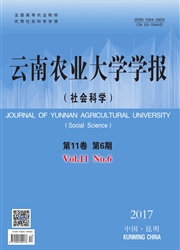

 中文摘要:
中文摘要:
温度对雌配子体选择较困难,研究报道较少。为探究温度对雌配子体基因型的选择作用,分别用高温和低温处理孕穗期和开花期的杂交组合群体(合系41A/‘小麻谷’、合系42A/‘小花谷’),并授予‘南34’花粉,共产生22个F1雌配子体基因型选择群体及其后代F2分离群体。对种植于3个不同海拔环境的这些群体的6个形态性状进行分析,结果显示:温度差异对水稻F1雌配子体基因型具有选择作用,并影响到F2代表型的遗传分离;高温35℃的选择作用大于低温16℃,开花期选择作用大于孕穗期;低温处理的选择群体,种植在海拔2 200 m和1 860 m的结实率高、但整体长势较差,而高温处理的选择群体长势较强、但结实率低。此外,海拔差异对各世代群体的表型有影响,其中1 860 m海拔的影响最小。本研究结果为利用温差对雌配子体选择育种提供一定的参考。
 英文摘要:
英文摘要:
It is difficult to conduct temperature on female gametophyte selection. It is rare research on it. For exploring the selection of gametophyte, we treated booting stage and flowering stage with differ- ent temperatures and pollinated with ' Nan34' , which produced 22 F1 female gametophyte genotype se- lection populations and their corresponding progeny F2 segregation populations. Six morphological traits of these F1 and F2 populations grown at three different altitude environments were analyzed. It was found that high and low extreme temperatures caused female gametophyte selection in the F1 populations, and then affected the phenotype genetic differentiation of their F2 progeny populations. The ex- pression of selection effect at high temperature 35 ~C treatment was stronger than at low temperature 16 ~C, that at flowering stage was also stronger than at booting stage. The selection populations which were treated by low temperature treatment and grew at altitude of 2 200 m and 1 860 m appeared the higher setting rate and weaker growth potential, but the trend at high temperature treatment was reverse. In addition, different altitude environments could affect the expression of morphological characters and the effect at the altitude of 1 860 m was weak. The results provide a reference for developing breeding method of female gametophyte genotype selection.
 同期刊论文项目
同期刊论文项目
 同项目期刊论文
同项目期刊论文
 期刊信息
期刊信息
